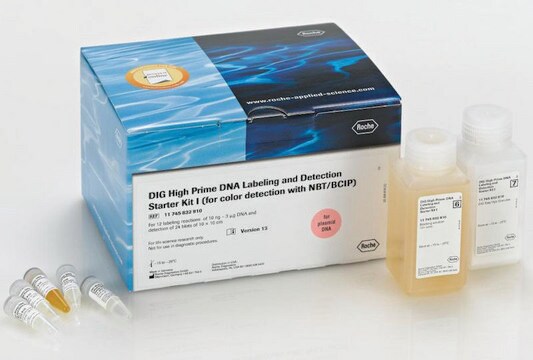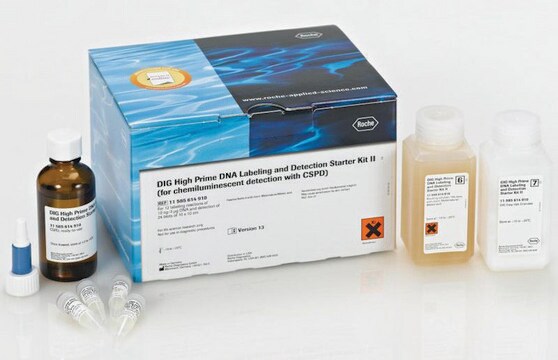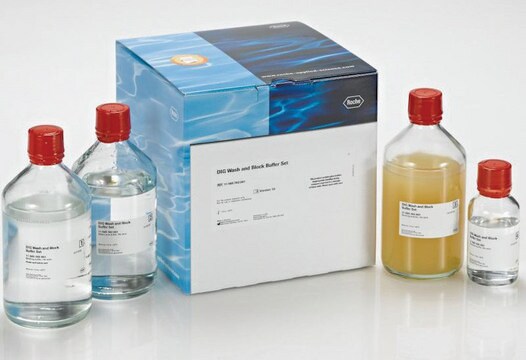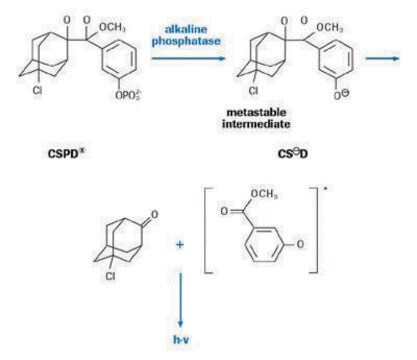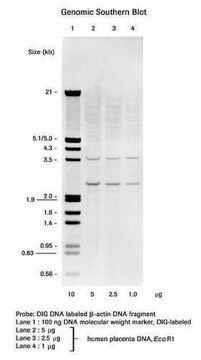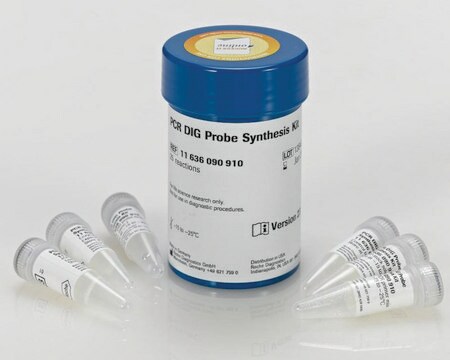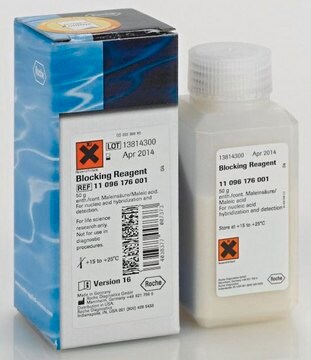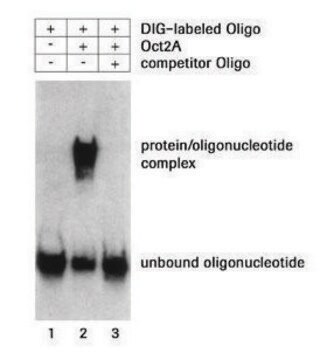Wichtige Dokumente
11175041910
Roche
DIG Nucleic Acid Detection Kit
sufficient for 40 blots (10 cm x 10 cm each), kit of 1 (5 components), suitable for hybridization, suitable for Northern blotting
Synonym(e):
DIG system
About This Item
Empfohlene Produkte
Verwendung
sufficient for 40 blots (10 cm x 10 cm each)
Qualitätsniveau
Verpackung
kit of 1 (5 components)
Hersteller/Markenname
Roche
Grünere Alternativprodukt-Eigenschaften
Designing Safer Chemicals
Learn more about the Principles of Green Chemistry.
sustainability
Greener Alternative Product
Methode(n)
Northern blotting: suitable
Southern blotting: suitable
hybridization: suitable
Grünere Alternativprodukt-Kategorie
, Aligned
Lagertemp.
−20°C
Allgemeine Beschreibung
Anwendung
- Southern blots
- Northern blots
- Other nucleic acid blotting applications
- In situ hybridization applications
- Southern blots
- Northern blots
- Other nucleic acid blotting applications
- In situ hybridization applications
Leistungsmerkmale und Vorteile
Verpackung
Prinzip
Angaben zur Herstellung
Working concentration of conjugate depends on application and substrate.
Storage conditions (working solution):
- Anti-Digoxigenin-AP Conjugate (vial 3): 2 to 8 °C, it is stable for 12 months at this temperature
- NBT/BCIP (vial 4): 2 to 8 °C, stable
Note: During shipment of the kit on dry ice, a precipitate may occur which is dissolved by briefly warming to 37 °C - The blocking reagent (vial 5) is stable for 36 months and can be stored dry at 4 to 8 °C.
- Autoclaved stock solution can be stored for several days to a week either unopened at 15 to 25 °C or at 4 to 8 °C after opening. Alternatively, it can be stored in aliquots at -15 to -25 °C for up to 6 months.
Nur Kit-Komponenten
- DIG-labeled Control DNA 5 µg/ml
- DNA Dilution Buffer, [50 μg/ml] fish sperm DNA
- Anti-Digoxigenin-AP Conjugate antibody 750 U/ml
- NBT/BCIP, 50x stock solution 50x concentrated
- Blocking Reagent
Lagerklassenschlüssel
11 - Combustible Solids
WGK
WGK 3
Flammpunkt (°F)
does not flashNot applicable
Flammpunkt (°C)
does not flashNot applicable
Analysenzertifikate (COA)
Suchen Sie nach Analysenzertifikate (COA), indem Sie die Lot-/Chargennummer des Produkts eingeben. Lot- und Chargennummern sind auf dem Produktetikett hinter den Wörtern ‘Lot’ oder ‘Batch’ (Lot oder Charge) zu finden.
Besitzen Sie dieses Produkt bereits?
In der Dokumentenbibliothek finden Sie die Dokumentation zu den Produkten, die Sie kürzlich erworben haben.
Kunden haben sich ebenfalls angesehen
Artikel
Digoxigenin (DIG) labeling methods and kits for DNA and RNA DIG probes, random primed DNA labeling, nick translation labeling, 5’ and 3’ oligonucleotide end-labeling.
Unser Team von Wissenschaftlern verfügt über Erfahrung in allen Forschungsbereichen einschließlich Life Science, Materialwissenschaften, chemischer Synthese, Chromatographie, Analytik und vielen mehr..
Setzen Sie sich mit dem technischen Dienst in Verbindung.